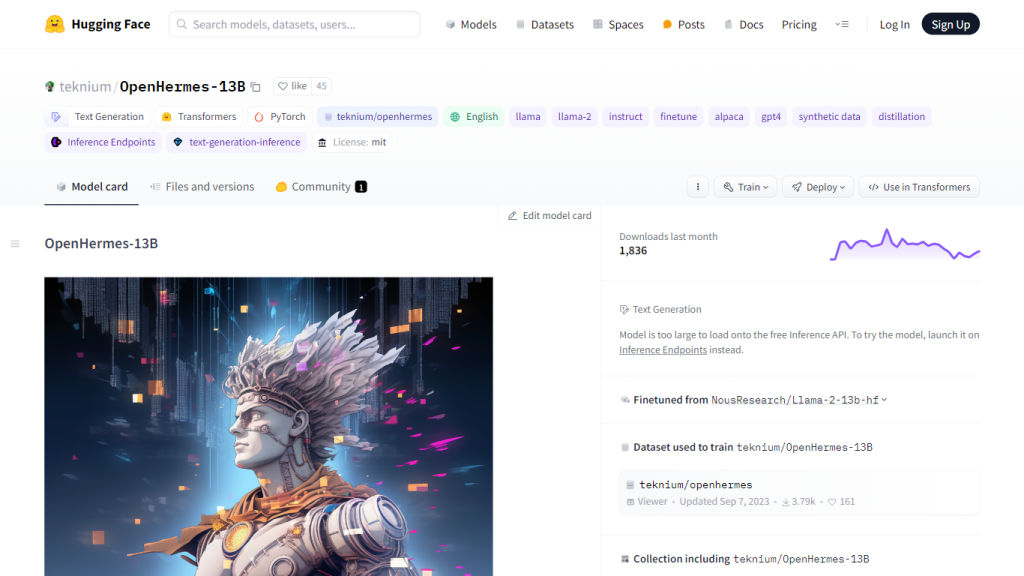What is OpenHermes-13B?
OpenHermes-13B is an AI model trained to a very great extent on a dataset created almost entirely by GPT-4. The model, developed by Teknium in collaboration with many leading companies such as WizardLM Team and Microsoft, is trained for advanced text generation. It was trained on an entirely open-source dataset of 242,000 entries setting out to bittegaize the outputs of communication and remove AI disclaimers and refusal notices.
OpenHermes-13B was sponsored by a16z, who received compute resources from main_horse. On the side of transparency, this training is open to the public via WANDB Project.
OpenHermes-13B: Key Features & Benefits
Advanced Training Dataset: It is trained using the Hermes dataset, fine-tuned on GPT-4 generated data for many AI solutions.
Open Source Contribution: Contributions from many AI industry contributors toward an open-source approach.
Filtering Information: Filtered especially the content, including OpenAI refusals and disclaimers, to increase the quality of the output.
Benchmark Performance Analysis: It leads on most benchmark suites, most notably GPT4ALL, BigBench, and AGI-Eval.
Transparent Training Procedure: The details of the training process are available to all through WANDB Project logs.
By having a strong and diversified dataset, OpenHermes-13B allows for improved text generation capacity to be achieved, thus very essential for a number of applications. Disclaimers and refusal strategic filtering will lead to compact output for communication.
Use cases and Applications of OpenHermes-13B
OpenHermes-13B can be applied in a wide array of cases, including but not limited to the following:
- Customer Support: Response during customer support can be automated and improved by quick and accurate information to be provided.
- Content Creation: Devise quality content on your blogs, articles, and social media posts.
- Research Assistance: Tools summarize and analyze a huge volume of data into meaningful insights for academic and professional researches.
- Chatbots: Enhance the conversational ability of chatbots to communicate more naturally and engagingly.
Integration of OpenHermes-13B into workflows in industries such as technology, media, education, and customer service has been very effective. The diversity of its usages manifests its versatility and potency in boosting text generation and communication processing.
How to Use OpenHermes-13B
Using OpenHermes-13B is rather straightforward. Here is how to do it, step by step:
- Access the Model: OpenHermes-13B can be found on Hugging Face. You can thus access the model from their platform itself.
- Set Up Your Environment: Be sure to have all the proper libraries installed and dependencies, at a minimum, the Hugging Face transformers library.
- Load the Model: Use the API to load OpenHermes-13B into your application.
- Generate Text: Provide your prompts and let OpenHermes-13B generate text outputs of your choice.
For the best results, we recommend familiarization with the parameters of the model and trying different input prompts. This WANDB Project logs can also be very useful for showing the training process of the model and performance metrics.
How OpenHermes-13B Works
OpenHermes-13B is powered by advanced machine learning algorithms; however, it majorly depends on the GPT-4 architecture. The model has been fine-tuned on a dataset containing diverse entries that were collected from multiple AI solutions.
Training consisted of the incorporation of a host of datasets that included GPTeacher, Airoboros, Camel-AI, CodeAlpaca, WizardLM, and Microsoft’s GPT4-LLM and Unnatural Instructions datasets. Strategic filtering with regard to certain content, such as AI disclaimers and declinements, was done to focus on ensuring quality and relevance in generated output.
A prompt is fed in and the model processes this input to come up with coherent and contextually appropriate text based on the training data. WANDB project logs for the training procedure and used hyperparameters are publicly available.
OpenHermes-13B Pros and Cons
Pros: Good quality text generation, open source contributions to it, transparency in training, and strategic content filtering.
Drawbacks: A slight degradation in certain benchmark suites, like AGIEval, as compared to the quality of the original Hermes model.
User feedback primarily outlines that the model works very well to realize situations and create accurate and contextually relevant text. Still, some users underlined a minor performance degradation in specific benchmarks.
Conclusion about OpenHermes-13B
OpenHermes-13B becomes a very powerful model in text generation due to its state-of-the-art training dataset, open-source approach, and filtering strategy. This versatility lends itself to several applications across multiple industries, thus adding value to communication and content creation processes.
Though minor disadvantages exist in benchmark performances, overall advantages and user feedback definitely underline its effectiveness and reliability. Further updates and developments are yet to be done which shall further raise the capabilities of this model in a definite way, making it a lead solution in the AI domain.
OpenHermes-13B FAQs
What is OpenHermes-13B?
OpenHermes-13B is an ultra-advanced AI model fine-tuned on datasets primarily generated by GPT-4, developed by Teknium and available via Hugging Face.
What datasets were used in training OpenHermes-13B?
It was trained on dataset contributions from GPTeacher, Airoboros, Camel-AI, CodeAlpaca, WizardLM, and Microsoft’s GPT4-LLM and Unnatural Instructions datasets.
Is the WANDB Project for OpenHermes-13B public?
Yes, this project in WANDB is public and can be inspected to get a good understanding of how OpenHermes-13B was trained and fine-tuned.
Who sponsored the development of OpenHermes-13B?
OpenHermes-13B was sponsored by a16z and supported with compute access by main_horse.
What improvements does OpenHermes-13B hold over previous models?
OpenHermes-13B showed slight improvements on some benchmarks like GPT4ALL Suite and BigBench Suite, some degradation in AGIEval compared to the original Hermes model.










